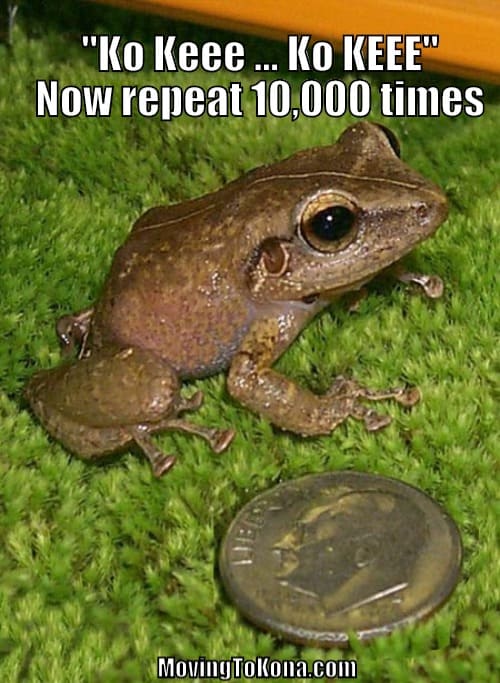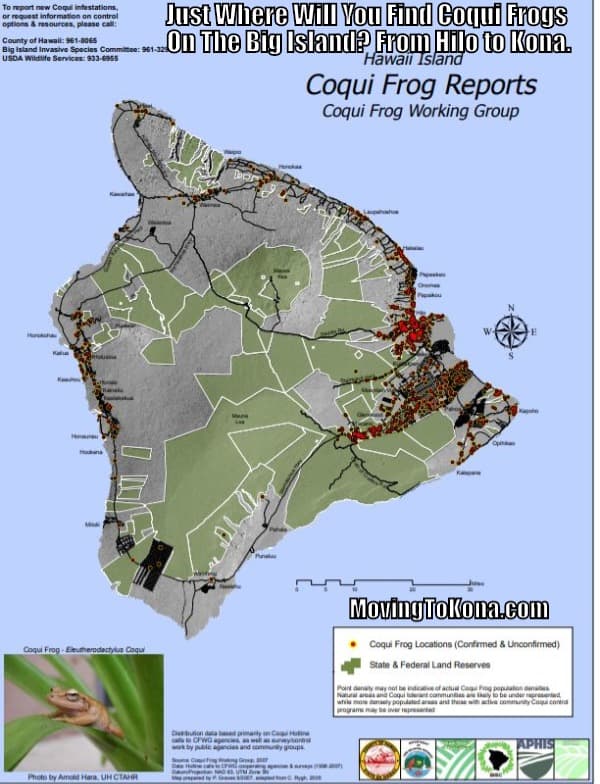The Hills Are Alive With The Sound Of… Coqui Frogs
“Ko Keee … Ko KEEE.”
Now repeat that from sunset to sunrise.
“Ko Keee … Ko KEEE.”
“Ko Keee … Ko KEEE.”
“Ko Keee … Ko KEEE.”
We have included an Aloha tip if you are buying a home in Kona – see below.
Sleepless in Hawaii – The First 60 Minutes Of The Coqui Frog Sounds Are Enchanting: The next 11 hours can be brutal. The coqui frog is active at dusk and well into the night, and has a disproportionately loud voice for its diminutive size (much like my mother-in-law). You can click here to hear the distinctive coqui call – the symphony of hundreds version – or watch the video below.
Who Doesn’t Know The Famous Coqui Song By The Beatles?
It was thirty years ago today
That coqui frogs came to stay
They’ve had their own serenading type of style
And they’re guaranteed to keep you up for a while
So may I introduce to you
The act you’ve known for all these years
Sgt. Pepper’s Lonely Hearts Coqui Choral Band
Coquis And The Big Island – Fast Fact: Coquis have only been in Hawai’i since the 1980’s. The coqui frog is currently widespread on the island of Hawaiʻi but is only known to be in a few locations on the island of Maui, Kauaʻi, and Oʻahu. They are not present on Molokaʻi or Lanaʻi.
Just How Loud Are Coquis? The coqui screeching call is made by males, which contract their bodies, squeezing the air out of their lungs and into their vocal sacs. Females seem to respond to both the frequency and volume of the call, which can reach from 70 to 90 decibels, comparable to a vacuum cleaner or a garbage disposal. (The federal government calls for workplace ear protection when noise reaches 85 decibels.)
Bonus Aloha Tip – Hawaii Real Estate: If you are renting or buying a home, since coquis do their calls after dark, you need to visit your prospective property after sunset. I remember the first time this was evident to me. We live in a gated community that as an active ‘coqui control’ program. We rarely hear coqui sounds. One day I got home late and went to the central mailbox, which is on the perimeter of the gated community. As soon as I stepped out of the car I could hear a chorus of coquis from the community across the street. So if you want to buy a home in Kona, take it for a test listen first, just so you know…
Just What Are Coqui Frogs? The Coqui Frog (Eleutherodactylus Coqui) is an invasive species that came from Puerto Rico, probably in a shipment of nursery plants, in the 1980s. The coqui is a small tree frog slightly larger than one inch long with a roundish body shape. Coquis can vary from a light yellow to dark brown color. They are generally found at ground level and in trees and bushes. Some are about the size of a dime or a quarter.
Coqui Distribution: Coqui frogs do not travel very far on their own as they are small, but they are opportunists so when given the chance to hop on a nursery plant, flowers, or vehicle, they can quickly spread. Coquis spread among the Hawaiian Islands via the shipment of plants or even catching a ride on vehicles. The coqui frog is currently widespread on the island of Hawaiʻi but is only known to be in a few locations on the island of Maui, Kauaʻi, and Oʻahu. They are not present on Molokaʻi or Lanaʻi.
Coqui Environmental Impact: There are no natural predators to keep populations in check so frog populations have reached 55,000 frogs per hectare (2.5 acres) in some Hawaii populations. A few coqui considerations are:
- Coquis consume huge quantities of insects, removing insects from forest floor to treetops.
- Coquis can cause a loss of insect services such as those helping with pollination.
- Coqui females producing an average of 28 eggs four times a year.
- Coquis disrupt the balance of vulnerable native ecosystems.
- Coquis cause a loud, incessant and annoying call from dusk until dawn.
- Coquis can have an adverse economic impact on tourism.
- Coquis can have an adverse economic impact on real estate sales. Disclosure requirement for real estate transactions, has resulted in decreased property values in some locations.
- Coquis lead to a decreased export plant sales.
From A Coqui Lover: The coqui sound is soothing, and more like 70 decibels. They are not eating all the insects, as anyone on the Big Island can attest. They control insect pests, including mosquitoes and fire ants. They are good for the garden. And they have not affected property values. There are numerous predators for the coqui, including birds, rodents, cats, mongooses, and other coquis
Amazon Products
What Happens If You Are Caught With A Coqui? Sure they are cute and who wouldn’t want their own personal ‘nature sounds’ sound machine? Any person or organization who intentionally transports, harbors or imports with the intent to propagate, sell, or release the coqui is in violation of State law and may be charged with a class C felony and subject to a minimum fine of $50,000 and a maximum fine of $200,000, plus three years in prison.
Just Where Will You Find Coqui Frogs On The Big Island? From Hilo to Kona. From Hawi to Pahoa.
How To Eradicate Coqui Frogs: Spray commercially available citric acid on infested plants to kill coqui frog eggs, juveniles, and adult males and females. Citric acid is a common food additive and is considered safe for environmental use by the EPA. Citric acid (anhydrous, or dry powder) can be obtained in 50 lb bags or in repackaged 5 and 10 lb bags from chemical or garden supply stores. It must be first mixed with water to make a 16% (w/v) solution (1.3 lb citric acid per 1 gallon of water). (Note: 16% citric acid is now available ready-to-use as a premixed solution at most garden shops.)
Coqui frogs are killed by direct contact with the spray and not by its residue. For maximum effectiveness, spraying should be done following removal of dense shrubs and dead foliage to increase contact with the frog. In landscaped or vegetated areas, spray in the early evening after a drizzle or heavy rain, when frogs start to call, rather than during a dry period or drought when frogs remain hidden and call less frequently. Moderate to heavy rain will dilute and wash away sprayed citric acid, so consult the weather forecast prior to spraying. Thorough coverage of plants with the citric acid solution (including undersides of leaves where frogs may be hiding) is important. Spray or hand-capture frogs agitated by the citric acid that may jump out of the plants before they can find another hiding place.
Frogs that are not directly contacted during spraying may retreat and males may refrain from calling for a few days before re-emerging. Spray again after two-weeks (time it takes for eggs to hatch) and monitor for calling males up to one year (time it takes for hatchlings to mature).
And now, one more song, it is time for the ‘sing-along’ portion of this post (with apologies to Julie Andrews):
“The Hills Are Alive With The Sound… Of Coquis”
The hills are alive,
With the sound of coquis
With songs they have sung
For pver 30 years
The hills fill my heart,
With the sound of coquis
My heart wants to sing
But my ears can’t hear
(you get the idea)
The original, “The Hills Are Alive…” song is below.


